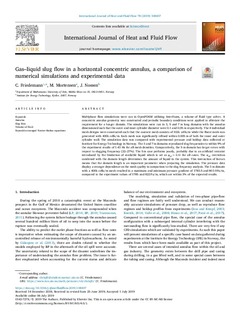| dc.contributor.author | Friedemann, Christopher | |
| dc.contributor.author | Mortensen, Mikael | |
| dc.contributor.author | Nossen, Jan | |
| dc.date.accessioned | 2019-08-16T11:03:20Z | |
| dc.date.available | 2019-08-16T11:03:20Z | |
| dc.date.created | 2019-07-30T15:25:45Z | |
| dc.date.issued | 2019 | |
| dc.identifier.citation | International Journal of Heat and Fluid Flow. 2019, 78 , 108437 | nb_NO |
| dc.identifier.issn | 0142-727X | |
| dc.identifier.uri | http://hdl.handle.net/11250/2608738 | |
| dc.description.abstract | Multiphase flow simulations were run in OpenFOAM utilizing InterFoam, a volume of fluid type solver. A concentric annulus geometry was constructed and periodic boundary conditions were applied to alleviate the requirement for a longer domain. The simulations were run in 3, 5 and 7m long domains with the annulus dimensioned such that the outer and inner cylinder diameter were 0.1 and 0.05m respectively. The 4 individual mesh designs were constructed such that the coarsest mesh consists of 102k cells/m while the finest mesh was generated with 400k cells/m. Each mesh was significantly refined within 0.005m of both the inner and outer cylinder wall. The simulation data was compared with experimental pressure and holdup data collected at Institute for Energy Technology in Norway. The 3 and 7m domains reproduced slug frequencies to within 9% of the experiment results of 1.43 Hz for all mesh densities. Comparatively, the 5m domain has larger errors with respect to slugging frequency (22–27%). The 5m case performs poorly, probably due to an artificial restraint introduced by the limitation of available liquid which is set as oil = 0.53 for all cases. The αoil restriction combined with the domain length determines the amount of liquid in the system. This interaction of factors means that the domain length is an important parameter when preparing the simulation. The pressure data display a stronger dependence on the mesh quality in comparison to the slug frequency analysis. The 3m domain with a 400k cells/m mesh resulted in a maximum and minimum pressure gradient of 1783.5 and 803.9 Pa/m, compared to the experiment values of 1785 and 822 Pa/m, which are within 3% of the expected results. | |
| dc.language.iso | eng | nb_NO |
| dc.rights | Attribution-NonCommercial-NoDerivatives 4.0 Internasjonal | * |
| dc.rights.uri | http://creativecommons.org/licenses/by-nc-nd/4.0/deed.no | * |
| dc.title | Gas-liquid slug flow in a horizontal concentric annulus, a comparison of numerical simulations and experimental data | nb_NO |
| dc.type | Journal article | nb_NO |
| dc.type | Peer reviewed | nb_NO |
| dc.description.version | publishedVersion | |
| dc.source.pagenumber | 14 | nb_NO |
| dc.source.volume | 78 | nb_NO |
| dc.source.journal | International Journal of Heat and Fluid Flow | nb_NO |
| dc.identifier.doi | 10.1016/j.ijheatfluidflow.2019.108437 | |
| dc.identifier.cristin | 1713307 | |
| dc.relation.project | Norges forskningsråd: 255481 | nb_NO |
| cristin.unitcode | 7492,3,1,0 | |
| cristin.unitname | Strømningsteknikk | |
| cristin.ispublished | true | |
| cristin.fulltext | original | |
| cristin.qualitycode | 1 | |

